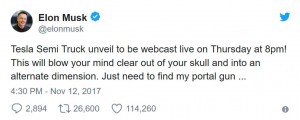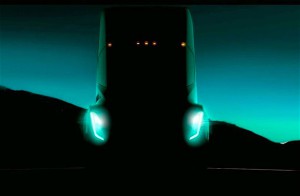
Tesla CEO Elon Musk is telling folks to be ready to have their "mind blown" with the long-awaited introduction of Tesla's semi truck on Thursday.
Prepare to have your mind blown “clear out of your skull,” or so promises Elon Musk, the Tesla CEO confirming the repeatedly delayed debut of his company’s new battery-powered semi-truck will finally take place on Thursday evening.
Big trucks suck down diesel fuel at a tremendous rate and they generate a disproportionate share of transportation-based pollution. In Los Angeles, for example, the semis waiting at the city’s two huge ports are considered one of its primary smog sources. So, there’s growing demand for clean trucks. Musk, for his part, has been broadly hinting that Tesla’s answer is a semi that will share some of the same powertrain technology as its battery-powered Models S, X and 3.
“This will blow your mind clear out of your skull and into an alternate dimension,” said the never-subtle, South African-born entrepreneur in his latest truck tweet.
Some observers are questioning the timing of the announcement, coming at a time when they say Tesla should be focused on the troubled production launch of its Model 3. Operations at the company’s Fremont, California, assembly plant has been severely troubled since the battery sedan went into production in July. Indeed, the unveiling of the Tesla Semi has been delayed twice in recent months to let the company and its engineers focus on the Model 3.
(Tesla hit by lawsuit, called “hotbed for racist behavior.” For the story, Click Here.)
Tesla has already dropped some hints about what it will reveal on Thursday during an 8 p.m. West Coast event. The full-sized truck is expected to yield several hundred miles per charge using lithium-ion batteries coming from Tesla’s new Gigafactory in Reno, Nevada.
That raises questions about how viable the Tesla offering will be for shipping firms that are used to diesel-powered trucks capable of running for anywhere from 500 to 1,000 miles between fill-ups. It’s not only the limited range that worries some observers, but also the amount of time needed to recharge the batteries the Tesla Semi would use.
The California automaker has been setting up a nationwide network of Superchargers, superfast, high-voltage charging systems capable of giving a vehicle like the Model S an 80% top-off of its batteries within 30 minutes or so. But a battery pack for an 18-wheeler would be substantially larger, and substantially slower to recharge – and the current Supercharger network would have to be super-sized to handle a truck alongside Tesla’s passenger cars.
But one of the mind-blowing solutions that observers seem to expect would be the availability of a battery swapping system. Musk previously showed off that concept with the Model S, though it is not likely to be used for the company’s passenger vehicles. But it would make sense if the Semi’s pack were mounted in a way that would allow for a discharged battery pack to be readily swapped out for a fully charged one, either at a freight depot or roadside service center.
Whether that would be enough to compensate for a Tesla Semi’s shorter range is uncertain, though a fair amount of truck traffic isn’t long-haul. Many of those LA port trucks, for example, will simply pick up cargo units off-loaded from freighters and then haul them to nearby warehouses and depots.
(Click Here for more about an analyst ripping the Model 3 and its “shortcomings.”)
For such users, Musk has promised, an electric Semi will “deliver a substantial reduction in the cost of cargo transportation, while being safer and really fun to operate.”
But even if battery-powered trucks do find a niche in the freight-hauling industry, that’s no guarantee Tesla will dominate the market. The company has already stretched its cash coffers severely. During a conference call to discuss Tesla’s third-quarter losses, its CFO acknowledged the company is delaying investing in the machinery needed to double the capacity of its Fremont plant. A number of Wall Street analysts believe Tesla will have to raise new capital just to get up to full speed with the Model 3. Whether it has the cash to actually build the Semi is another matter.
And then there’s the fact that a number of competitors are entering the clean truck segment. That includes Daimler AG, which owns five different truck brands, including U.S.-based Freightliner. It has just launched a medium-duty electric and has others in development. Volkswagen recently committed more than $1 billion for its own electric truck push.
A number of observers believe that the real market for battery freight-haulers will be in the medium-duty segment, rather than Semis, at least until extended-range batteries become available.
There are also several companies looking to market hydrogen-powered Semis. That includes Salt Lake start-up Nikola Motors, as well as Toyota, which recently began testing a fuel-cell truck at those LA ports. Hydrogen semis will be able to get as much as 1,000 miles on a tank, or so says Nikola, which would obviate the range issue. But the challenge will be finding the clean, lightweight gas. Currently, there are only a handful of hydrogen stations, most in California. Nikola has promised to set up its own distribution network, much like Tesla has done with its Superchargers.
(To see more about the reasons behind the semi-truck delays, Click Here.)
Which technology – and which manufacturer – will win is far from certain but it seems clear that cleaner trucks are on the way, and that should be a mind-blowing development.


“It’s going to be a really big show…”. Just Bigly!!